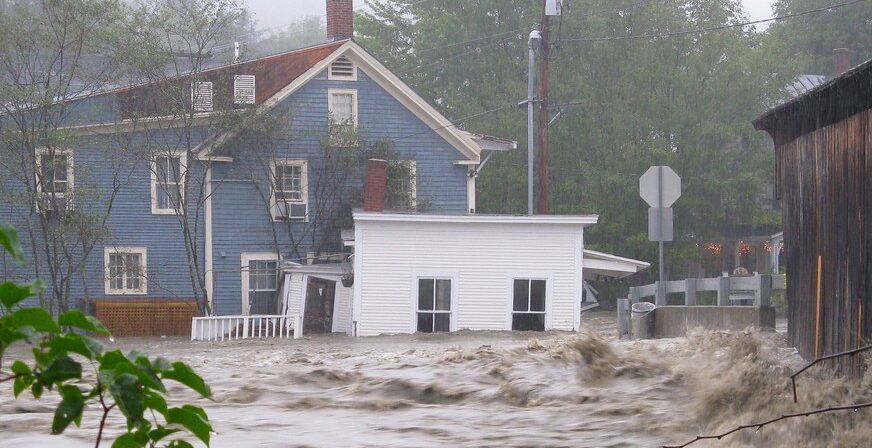It’s 2011 and we’re in Binghamton, New York. People here are mostly recovered from the massive flood of 2006 that displaced 20,000 people. Foundations have been repaired, carpets replaced, and homes rebuilt. Finally, people are feeling secure again.
After all, the flood of 2006 was what’s known as a “100-year flood,” which to most people means this magnitude of flooding is only seen every 100 years. Unfortunately, as we now know, this was not to be the case, and in September 2011 Binghamton was hit by yet another massive flood, this one from the remnants of Tropical Storm Lee.
How could something like this happen?
Confusing Terminology can be Dangerous
Years later, residents expressed their bewilderment at this seemingly improbable event. “They call it the 100-year flood, so you figure you’re safe for quite a while, but we were only safe for 5 years,” said one resident in 2017.
This description of the 100-year flood is quite typical, and understandable. Nevertheless, it’s flawed, which goes to the heart of an issue that pits the world of probability against common sense. The result, unfortunately, is that people are put at risk. To examine this, let’s dissect what a term like the “100-year flood” actually means.
The 100-year Flood–Differentiating the Improbable from the Impossible
Statistically speaking, the 100-year flood is the flood level that has a 1% chance of occurring every year. If such a flood has a 1% chance of occurring every year, it follows that every 100 years there is a very high probability of experiencing such a flood–hence the term. However, just because it’s called the 100-year flood doesn’t mean it cannot occur at shorter intervals.
This single point is where a lot of common misperception comes from. Many people hear the term “100-year flood” and perceive such a flood as deterministic: “It will happen every 100 years” (Bell & Tobin, 2007). In reality, flood risk is always probabilistic: “It is highly likely that it will occur every 100 years”.
Furthermore, there is a relatively high chance that the 100-year flood will occur more than once every 100 years. Because it has a 1% chance of occurring every year, that means it has a 25% chance of occurring every 25 years, 50% chance every 50 years and so on.
So while yes, the back-to-back floods of 2006 and 2011 in Binghamton were improbable, they were not impossible! Unfortunately for flood victims, this small distinction is important and ends up catching many people off guard.
How to Prepare for Improbable Floods
So what can we do about this? It’s clear from the case of Binghamton that personal risk assessments are being derailed by the term “100-year flood,” leaving people vulnerable to the whims of probability.
Should we just force everyone to learn statistics?
I think we can do better than that. One proposal is to change the way risk is communicated. Experts in the field of flood-risk management have come up with several alternatives. Perhaps the best option would be to simply change the term itself. Several contenders include using “the 1% flood, or the “25% chance in 25-year flood.” Unfortunately, research has shown that these terms are also ambiguous (Bell & Tobin, 2007). The 1% flood sounds like something that never happens, and the 25% chance in 25-year flood sounds highly variable.
With these kinds of ambiguous results coming from the world of academia, I propose that it’s up to us to take flood risk into our own hands, especially with Climate Change upping the stakes very soon. Particularly regarding flooding, Climate Change could turn what is now the 500-year flood (a much larger but less probable flood) into the more likely 100-year flood. That means higher flood levels seen at more frequent intervals. Now more than ever, it is imperative that we educate ourselves about personal flood risk.
If you’re a current homeowner, or prospective home buyer, check out FEMA’s flood risk maps to assess the area where you live. If you live in New York and want to prepare for the future, check out this sea level rise mapper from Columbia University. There are lots of way to prepare for flooding, but the first step is to arm ourselves with information. Because as the case of Binghamton has shown, when the improbable strikes, you don’t want to be caught off guard.
Check out these other links to prepare for flooding:
FEMA’s Community Rating System: https://www.fema.gov/community-rating-system
National Flood Insurance Program: https://www.fema.gov/national-flood-insurance-program
FEMA Flood Smart Info: https://www.floodsmart.gov/
Planning for Sea-Level Rise Video: https://www.youtube.com/watch?v=ixT_Y8LCQZI&feature=youtu.be
Un-linked Source: Bell H, Tobin G. (2007). Efficient and effective? The 100-year flood in the communication and perception of flood risk. Environmental Hazards. Vol. 7, pp. 302-311
Image 1 Source: https://commons.wikimedia.org/wiki/File:Binghamton_University_Aerial_Photo.jpg
Image 2 Source: https://www.flickr.com/photos/usepagov/14604256462



